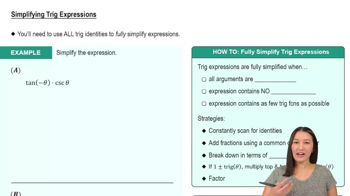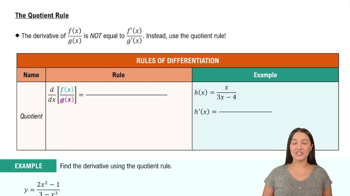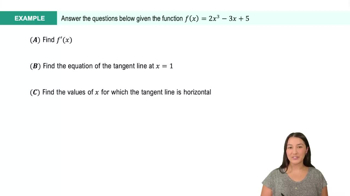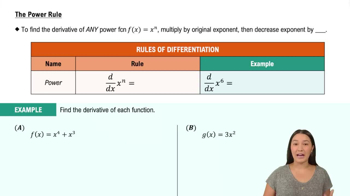Table of contents
- 0. Functions7h 52m
- Introduction to Functions16m
- Piecewise Functions10m
- Properties of Functions9m
- Common Functions1h 8m
- Transformations5m
- Combining Functions27m
- Exponent rules32m
- Exponential Functions28m
- Logarithmic Functions24m
- Properties of Logarithms34m
- Exponential & Logarithmic Equations35m
- Introduction to Trigonometric Functions38m
- Graphs of Trigonometric Functions44m
- Trigonometric Identities47m
- Inverse Trigonometric Functions48m
- 1. Limits and Continuity2h 2m
- 2. Intro to Derivatives1h 33m
- 3. Techniques of Differentiation3h 18m
- 4. Applications of Derivatives2h 38m
- 5. Graphical Applications of Derivatives6h 2m
- 6. Derivatives of Inverse, Exponential, & Logarithmic Functions2h 37m
- 7. Antiderivatives & Indefinite Integrals1h 26m
- 8. Definite Integrals4h 44m
- 9. Graphical Applications of Integrals2h 27m
- 10. Physics Applications of Integrals 2h 22m
3. Techniques of Differentiation
Basic Rules of Differentiation
Problem 3.3.58
Textbook Question
Find the derivative of the following functions by first expanding or simplifying the expression. Simplify your answers.
r(t) = (e2t + 3et + 2) / (et + 2)
 Verified step by step guidance
Verified step by step guidance1
Step 1: Identify the function r(t) = \frac{e^{2t} + 3e^{t} + 2}{e^{t} + 2}. This is a rational function, which can be simplified by performing polynomial long division if possible.
Step 2: Perform polynomial long division on the numerator (e^{2t} + 3e^{t} + 2) by the denominator (e^{t} + 2). Divide the leading term of the numerator by the leading term of the denominator to find the first term of the quotient.
Step 3: Multiply the entire divisor (e^{t} + 2) by the first term of the quotient obtained in Step 2, and subtract this product from the original numerator to find the new remainder.
Step 4: Repeat the division process with the new remainder obtained in Step 3, continuing until the degree of the remainder is less than the degree of the divisor.
Step 5: Once the expression is simplified, differentiate the resulting expression term by term using basic differentiation rules, such as the power rule and the constant rule, to find the derivative r'(t).
 Verified video answer for a similar problem:
Verified video answer for a similar problem:This video solution was recommended by our tutors as helpful for the problem above
Video duration:
2mPlay a video:
Was this helpful?
Key Concepts
Here are the essential concepts you must grasp in order to answer the question correctly.
Derivative
The derivative of a function measures how the function's output value changes as its input value changes. It is defined as the limit of the average rate of change of the function over an interval as the interval approaches zero. In calculus, derivatives are fundamental for understanding rates of change and are used in various applications, including optimization and motion analysis.
Recommended video:

Derivatives
Simplification of Expressions
Simplifying expressions involves rewriting them in a more manageable or understandable form, often by combining like terms, factoring, or using algebraic identities. In the context of derivatives, simplification can make it easier to apply differentiation rules and can lead to more straightforward calculations. This step is crucial for ensuring accuracy and efficiency in finding derivatives.
Recommended video:

Simplifying Trig Expressions
Quotient Rule
The quotient rule is a formula used to find the derivative of a function that is the ratio of two other functions. If a function is expressed as f(x) = g(x)/h(x), the derivative is given by f'(x) = (g'(x)h(x) - g(x)h'(x)) / (h(x))^2. This rule is essential when differentiating functions that are expressed as fractions, ensuring that both the numerator and denominator are correctly accounted for in the differentiation process.
Recommended video:

The Quotient Rule

 3:59m
3:59mWatch next
Master Derivatives of Linear Functions with a bite sized video explanation from Callie
Start learningRelated Videos
Related Practice







